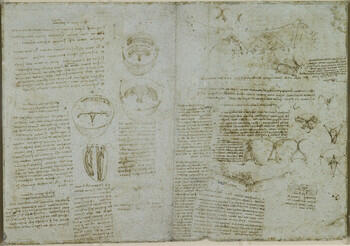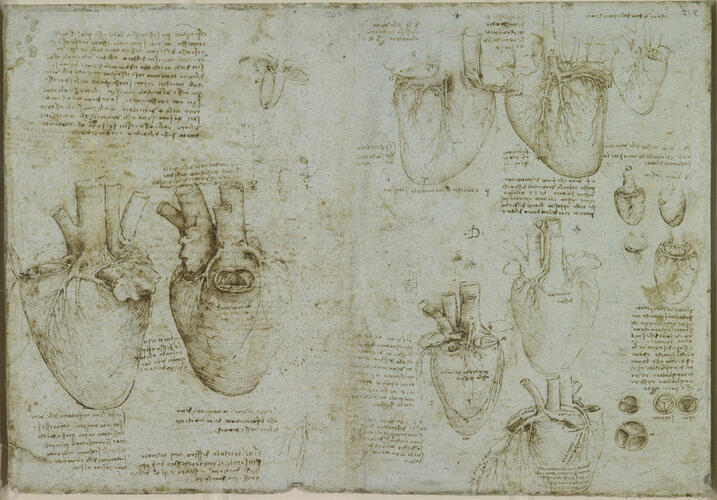-
1 of 253523 objects
The ventricles, papillary muscles and tricuspid valve (recto); The heart and coronary vessels (verso) c.1511-13
Pen and ink on blue paper | 28.8 x 41.3 cm (sheet of paper) | RCIN 919073

Leonardo da Vinci (1452-1519)
The ventricles, papillary muscles and tricuspid valve (recto); The heart and coronary vessels (verso) c.1511-13


-
Recto: on the left (historically RL 19073r), four sections of the ventricles of the heart, with notes on the drawings. On the right (RL 19074r), twelve diagrams illustrating the valves of the heart, with notes on the drawings.
The left page of this double sheet features four sections of an ox’s heart, showing the papillary muscles within the ventricles. The accompanying notes suggest two roles for those muscles: in diastole, to prevent the ventricles from dilating too far and thus drawing too much blood from the vessels; and in systole, to prevent the ventricles from closing completely, so that space remains in the left ventricle for some blood to pass through the septum from the right ventricle. The note at the top of the sheet discusses the functioning of the valves, stating that while closing the valves ‘always give passage first to a quantity of blood before they shut’ and thus ‘return back some of the blood to which they had previously given passage’. Leonardo appreciated that the valves are one-way structures, but this was obviously incompatible with a belief in the continuous flux and reflux of the blood (represented by a see-saw faintly drawn towards the bottom of the page), and so he denied the effectiveness of the valves. As Leonardo’s later studies confirmed their perfect closure, his acceptance of traditional physiology came under increasing tension.
The studies on the right-hand page present a significant advance in Leonardo’s understanding of the papillary muscles. He had observed that they are connected to the cusps of the valves by the chordae tendineae, and that these cords reinforce the cusps (of both the tricuspid and mitral valves) when the valves are closed in systole:
Nature has made the cords on the back side of the fleshy membrane of the three gates with which the gateway of the right ventricle is shut; and she has not made them on the front because these cusps feel more strain when they draw in blood than when they push it out.
The diagram along the top of the page is a sketch for the more finished drawing on 919078v, showing the tricuspid valve sectioned and opened out. Immediately below is a detail of the membranous sheaths of the chordae tendineae arising from the surface of the papillary muscle, and at lower centre is another ‘opened-out’ diagram that attempts to show how these membranous sheaths then flow onto the surfaces of the valve cusps.
In the right margin are geometrical diagrams analysing the structure of the tricuspid valve. Finally, at lower right is a section of the interventricular septum, with lines to indicate the fictitious pores through which subtilised blood was believed to pass from right to left ventricle: ‘and thus it must be drawn in order to make it understood’.
*
Verso: on the left (historically RL 19074v), two drawings of the whole heart, probably of an ox, and three diagrams demonstrating the function of the ventricles; with notes. On the right (RL 19073v), ten drawings of of the heart, and details of semilunar valves; notes.The largest drawings on the left page of this double sheet give two views of an ox’s heart with its auricular appendages. The pulmonary trunk has been removed to reveal the open three-cusped pulmonary valve. Rising from the centre of the heart is the aorta with its single brachiocephalic trunk; immediately adjacent are the superior and inferior vena cava – in the ox, the two venae cavae merge before they reach the atrium. The coronary arteries are seen leaving the base of the aorta and passing to either side of the pulmonary valve: the circumflex and anterior interventricular branches of the left coronary (travelling to the right as we look at the drawings) are particularly well shown. Above is a diagram in which the heart is sectioned longitudinally through each of the ventricles (cf. 919080); Leonardo thus established that ‘the right ventricle extends to a depth of three-quarters the length of the heart’.
The drawings on the right half of the sheet continue to examine the paths of the left and right coronary arteries. At upper centre, the left coronary artery is again shown splitting into its circumflex and anterior interventricular branches. In the drawing to the left of this, the heart is turned around to show the coronary sinus receiving veins from the left side of the heart and entering the right atrium at the base of the vena cava. Leonardo notes that the circumflex branch of the left coronary artery, labelled H, lies below the coronary sinus.
In the smaller drawings at centre right, Leonardo emphasises the encircling ‘crown’ of the coronary arteries and coronary sinus around the base of the heart, noting that these vessels ‘intersect like someone crossing his arms’. Below are four small diagrams of a three-cusped valve both open and closed.
Despite these direct physical observations of the anatomy of the heart, Leonardo’s understanding of its physiology remained rudimentary, and the passage at top left essentially reprises the notes on flux and reflux between ventricles and atria on 919062r.
(Text from M. Clayton and R. Philo, Leonardo da Vinci: Anatomist, London 2012)Provenance
Bequeathed to Francesco Melzi; from whose heirs purchased by Pompeo Leoni, c.1582-90; Thomas Howard, 14th Earl of Arundel, by 1630; probably acquired by Charles II; Royal Collection by 1690
-
Creator(s)
Acquirer(s)
-
Medium and techniques
Pen and ink on blue paper
Measurements
28.8 x 41.3 cm (sheet of paper)
Other number(s)
RL 19074